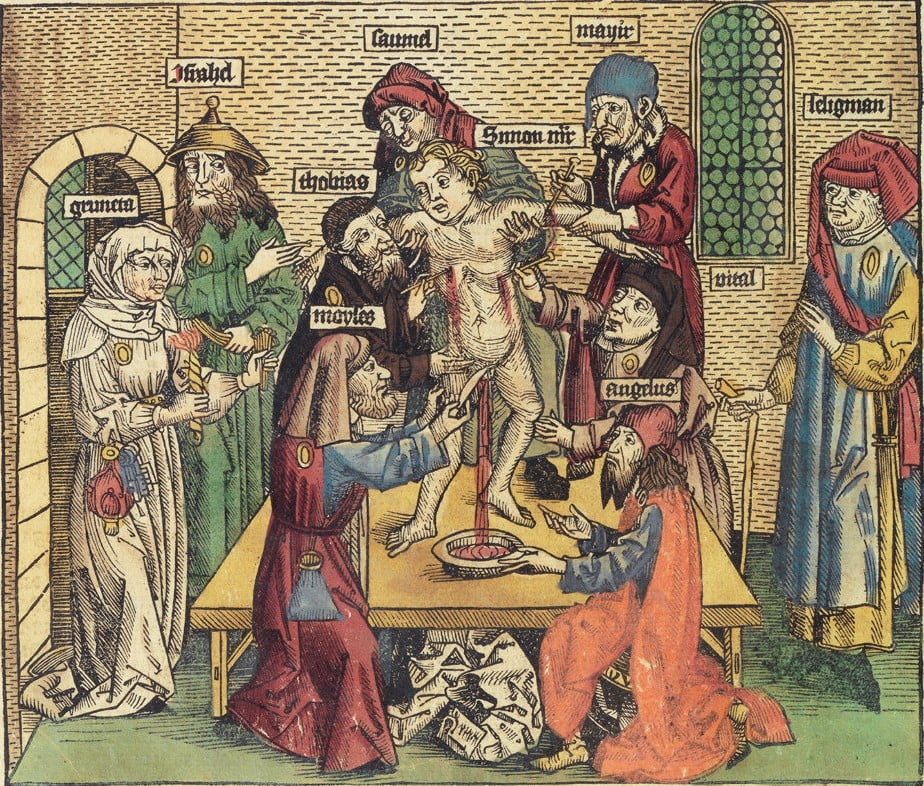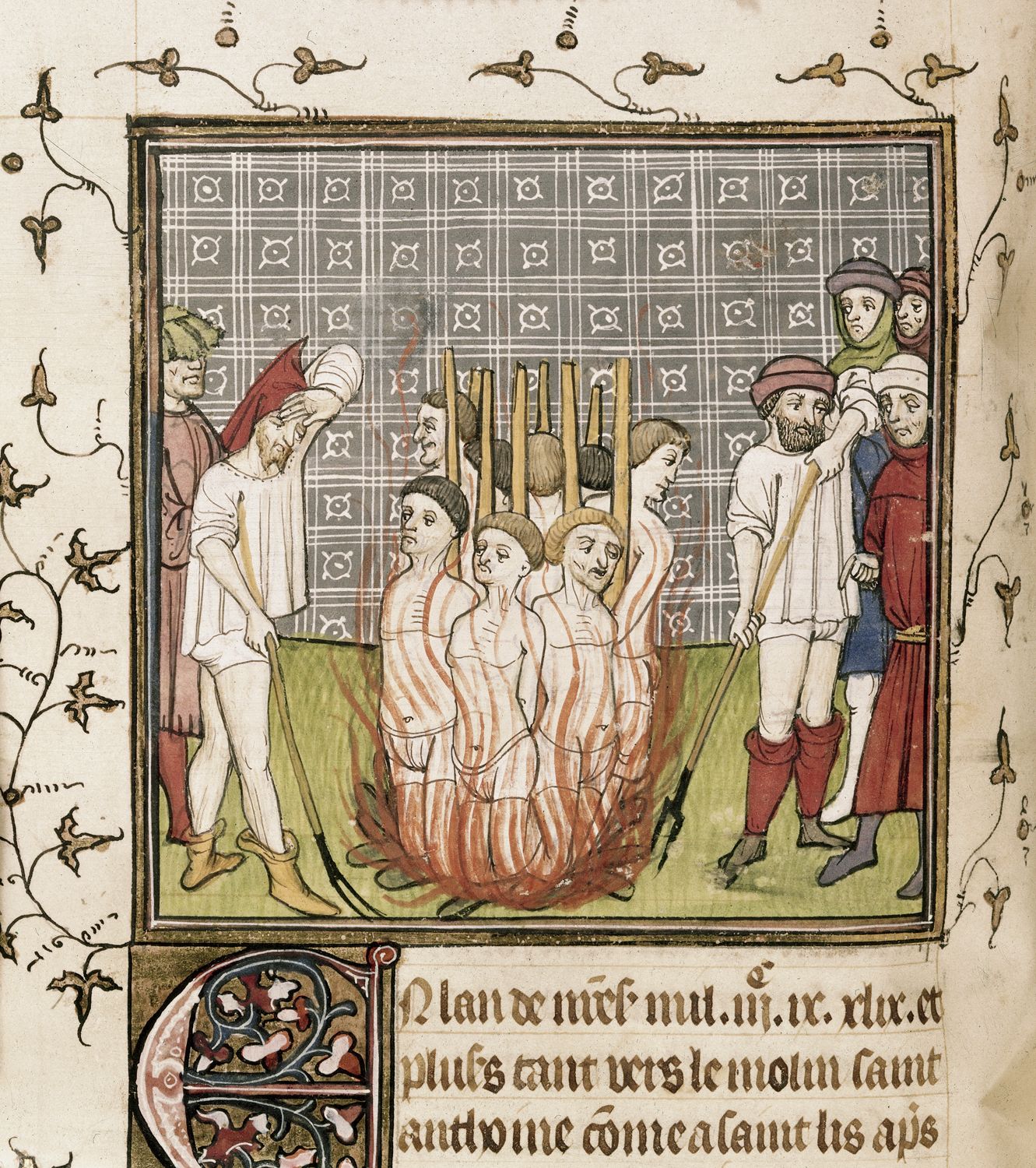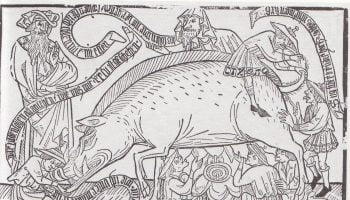This is Part XIX of The Public Medievalist’s continuing series on Race, Racism and the Middle Ages, by Michael Barbezat.
You can find the rest of our special series on Race, Racism and the Middle Ages here.
A persistent delusion exists Western culture: that shadowy, conspiratorial groups gather together in secret—preferably at night—to plot the overthrow of society. As part of their plotting, the conspirators supposedly ritually abuse, murder, and consume innocent children.
Ideas about this conspiracy have appeared repeatedly throughout our history. Historian Norman Cohn called this recurrent conspiracy theory “the nocturnal ritual fantasy.” Cohn argues that imperial Romans made these claims against early Christians; later medieval Christian authorities, in turn, made similar allegations against Christian heretics, Jews, and so-called “witches”. Belief in the nocturnal ritual delusion helped to justify deadly violence against these marginalized groups, and, in fact, played an important role in establishing their very marginality.
In all cases, the claims were false. They were nothing more than the imagined behaviour of fantastical enemies that existed more in the minds of those who feared them than in reality. The recent “Pizzagate Conspiracy” that came to a head during and in the wake of the recent American presidential election is a modern form of the nocturnal ritual fantasy. In this modern shape it is just as threatening as its past manifestations, with the threat of violence inherent in those who believe it.
What on Earth is “Pizzagate?”

The conspiracy theory behind Pizzagate goes something like this: Comet Ping Pong, a pizza restaurant in Washington D.C., is, allegedly, a front for a child sex-trafficking ring with deep connections to Democratic politicians (especially the Clintons) and their financiers. These associates of the Democratic Party would call the restaurant to place orders for “pizza” which, to them, was a code word for underage prostitutes. According to the conspiracy, the alleged organised sexual exploitation of children at Comet Ping Pong also had occult overtones. The participants in the ring were largely thought to be members of “illuminati-type” secret political societies, among whom ritualistic sex orgies were just one of many social/bonding activities.
Further complicating an already convoluted conspiracy, according to the Pizzagate believers, underneath the restaurant there are a series of labyrinthine tunnels and rooms. This underground network hosted ritualistic orgies, and connected Comet to the offices of the other organisations involved in the conspiracy. The members of the secret cult also, apparently, used arcane symbols to communicate with each other. The crossed ping pong paddles that the restaurant uses as its logo were, in reality, meant to represent a butterfly—which itself is, according to this theory, a secret symbol that deep-state paedophiles use to recognise one another. In case there was any confusion, let me emphasize, again, that all of these claims are entirely false.
Behind the Delusion
This delusional conspiracy theory took shape over the course of several months through innuendos on social media strained through a filter of intense homophobia. Why Comet Ping Pong? The restaurant’s owner, James Alefantis, is a gay man who once was in a relationship with David Brock, a prominent Hillary Clinton supporter. Brock was once a right-wing journalist. But, he became an “apostate” to the conservative case when he re-aligned himself with left-leaning politics. Comet Ping Pong had hosted democratic fundraisers. But perhaps most importantly, it is popular with beltway government employees, journalists, and politicians tied to liberal causes. It is also, as a profile on Slate put it,
both a neighborhood hang for young families as well as a reliable home for eccentrics, queers, outsiders, and their art.
Its stage has been a mainstay of DC’s punk scene, alt scene, and drag scene for over a decade. For the purposes of this supposed conspiracy though, it is a den of left-wing political insiders presided over by a homosexual, against a backdrop of a wide range of “queers”. Whatever one thinks those kinds of people get up to, Comet Ping Pong is an excellent setting for it.
As outrageous as a subterranean child-sex cult operating under a pizza parlour might sound, the story spread quickly and widely on right-wing media. It took off on a subsection of Reddit dedicated to Donald Trump [we don’t link to such sites, but if you must find it, we are referring to the The_Donald subreddit —ed.]. Well-known conspiracy theorist Alex Jones picked it up on his InfoWars radio program. The original Pizzagate subreddit is now closed to avoid “a witch hunt,” and Alex Jones has since apologised for promoting the story. But he has not exactly been chastened; he now calls Pizzagate a distraction from supposedly real conspiracies that threaten his listeners.
Long before Alex Jones’ quasi-apology, one of his listeners, Edgar Maddison Welch, believed what he was told. Armed with an AR-15 assault-style rifle, on December 4, 2016, he entered the popular pizza restaurant to find and to free the child sex slaves he believed were being held there. In his own words, he “just wanted to do some good.” In the restaurant, he brandished his weapon at employees, and fired it into the air about three times. But he found no children taken hostage. As it turns out, the building has no basement.
After Welch was arrested, he still believed it was possible that a hidden child-sex cult connected to liberal politics existed somewhere. But he admitted that “The intel on this wasn’t 100 percent.”
Medieval Pizzagates
The Pizzagate hoax closely follows the model of Cohn’s nocturnal ritual delusion, and has a number of medieval analogues. Take, for example, the sect of supposed Christian heretics near Soissons described by Guibert of Nogent in 1114. Guibert explained that these heretics had a number of unorthodox views on the sacraments, the role of priests, and human salvation. These opinions threatened, what he took to be, the fundamental order of the world.
Beyond their threatening theology, he also described how these heretics rejected heteronormativity by engaging in same-sex sex. They, according to Guibert, held secret meetings, grouping both men and women together, in “underground vaults or unfrequented cellars.” Guibert claimed that in the light of candles:
Some loose woman lies down for all to watch, and so it is said, uncovers her buttocks, and they present their candles at her from behind; and as soon as the candles are put out, they shout “Chaos” from all sides, and everyone fornicates with whatever person comes first to hand.
This is certainly not a regular church service.
But it doesn’t stop there: if one of the women became pregnant in the ritual, they apparently waited until the child was born before taking it back to the underground chamber. There, they tossed it back and forth through a fire until it died. But wait, there’s more: finally, they would take its ashes and make bread from them—and then use that as their sacrament of communion.
Guibert says that after authorities uncovered the sect, two of its leaders were confronted publicly by the Bishop of Soissons. One underwent the ordeal of water, where a person was thrown into a body of water, with their innocence proven by sinking. Perhaps sadly for this person, they failed it by floating.
The second confessed that he believed forbidden things, but refused to be reconciled to the Church. Both were then imprisoned. Soon after, a lynch mob took both of them from their cells and burned them alive.
Papal Persecutions and “Luciferians”
Accusations like Guibert’s continued to be made against supposed heretics. The thirteenth-century papal bull, Vox in Rama (A Voice in Rama), described a form of the nocturnal ritual fantasy that ultimately had an enormous influence over the later persecutions of other groups, particularly the Knights Templar and so-called witches.
In 1233 Pope Gregory IX issued Vox in Rama in response to reports from the Rhineland regarding a group of heretics labelled the “Luciferians.” These heretics, according to the Pope, gathered together in secret to conduct their rituals; their initiation rites were especially sordid. New members joined the sect at these meetings by first kissing toads, (thought in the Middle Ages to be poisonous), and then later by kissing an emaciated pallid man, who appeared during the rite. After sharing a ritual meal, a cat would appear, which they in turn would kiss on its hindquarters. Only after these escalating kisses, would the heretics engage in an indiscriminate orgy, like that earlier described by Guibert.
Templars and accused witches had similar accusations made against them. In the early fourteenth-century, the Templars were accused of conducting initiation rituals like those described in Vox in Rama, but with an even stronger emphasis on accusations of homosexual intercourse.
At the end of the Middle Ages and into the Early Modern period, the rituals ascribed to witches also followed this template. One of the earliest accounts of witches’ rites comes from the Malleus Maleficarum, published in 1486. The authors of the Malleus, Jacob Sprenger and Heinrich Kramer, argued that witches gathered together at night to fornicate with demons, the Devil, animals, and each other. They also reportedly killed children and used their body parts to work magic or ate them. Captured witches, when questioned, supposedly claimed that unbaptised babies were best.
Sprenger and Kramer also described how witches performed many other feats, such as flying through the air or apparently stealing men’s penises and storing them in bird’s nests or a handy cabinet (though they stressed that witches couldn’t really steal a man’s penis; witches could only make it look like they had).
Obviously, none of these tales are true. There were no witches. The Templars did not hold ritualistic homosexual orgies. King Philip IV “The Fair” of France destroyed the Templars in order to get access to their vast wealth, which he used to pay his massive debts. Philip understood the power of propaganda, and he regularly used the typology of the nocturnal ritual fantasy against his foreign and domestic enemies, including even Pope Boniface VIII.
Revealingly, no Templars confessed to Philip’s charges unless they had been tortured first. The causes for authorities’ pursuit of supposed witches are more complicated and variable than Philip’s attack upon the Templars. Explanations have ranged from tensions between Protestant and Catholic communities, especially in sixteenth-and seventeenth-century Germany where the majority of burnings occurred, to local politics, economics, and other factors. The point remains, however, that historians have continually found that the accusations made against so-called witches were patently false. The accusations against all these groups are part of what might be the oldest pattern of “fake news” that exists.
Jewish Conspiracy Libels

Medieval Jews were also often accused according to this pattern. One of the libels repeatedly levied against European Jews was that they kidnapped Christian boys and tortured them to death in a twisted re-enactment of Christ’s crucifixion.
These tales began in England with the fabricated story of the kidnap, ritual abuse and murder of the Christian boy William of Norwich, written and elaborated by Thomas of Monmouth between the early 1150s and 1174. In the middle of his imagining of William’s ritual crucifixion, Thomas has the Jews of Norwich pause to remark upon the fact that in the torture and murder of little William they are, finally, just as wicked as Christians expect them to be, saying: “That which they ascribe to us we will inflict on them.” In his write up, Thomas manifested his own negative opinions of Jews by putting them into the very mouths of imaginary Jews he presented as real. This is a circular logic that provides justification for prejudice based upon evidence generated by prejudice.
The belief that Jews tortured Christian children, which has come to be known as the “blood libel”, often featured a sexual component as well. In some versions of the blood libel accusation, kidnapped Christian boys were reportedly circumcised against their wills as depicted in a woodcut of the martyrdom of Simon of Trent in 1475. The Jews supposedly used the blood from this circumcision and other tortures to make the matzos for Passover.
Scholars now read accounts like Guibert’s as entirely delusional. According to medievalists such as R. I. Moore and Mark Gregory Pegg, most accounts of medieval heretics before the early thirteenth century are entirely invented. As Pegg argues most strenuously,
There were no pre-existing heresies in the twelfth and early thirteenth centuries until the thinking of Latin Christian intellectuals invented them. The ‘reality’ of heresy that these intellectuals so genuinely feared was actually fabricated by them.
Like the supposed continent-wide conspiracy behind witchcraft, or the secret torture cults of Jews they did not exist. Medieval authors made them up; they imagined them into being.
A Persecuting Society
Medieval authors and authorities created these accounts of heretics as part of their re-organisation of the world into what Moore calls a “persecuting society.” In the eleventh and thirteenth centuries, Western society underwent a permanent change in which “persecution became habitual.” In that period, Moore says:
deliberate and socially sanctioned violence began to be directed through established governmental, judicial and social institutions, against groups of people defined by general characteristics such as race, religion or way of life.
The trope of the nocturnal ritual fantasy played a role in the creation of this persecuting society. By creating an enemy that had to be fought, these authors justified the changes they wanted to make in their world. This legitimated their forceful suppression of other changes to the world that they did not want to see continue.
In Guibert’s case, the people he described did not exist, or at least they did not engage in the lurid behaviour he describes. But those heretics may have been some of the Christian reforming groups—composed of both men and women—like those studied by Herbert Grundmann. These groups were part of a wider movement that included figures who would become pillars of orthodox reform and others who would later be described as infamous heretics.
For example, Norbert of Xanten, founder of the Premonstratensian Canons, began as a poor preacher with both female and male followers, like the “heretics” described by Guibert. When his movement became an official order, his followers, who found official positions in the hierarchy of the Church, abandoned the mixing of the sexes. Much later, Waldes of Lyon, founder of the heretical Waldensians, and Francis of Assisi, founder of the Franciscans and later a saint, began their careers virtually identical to each other.
Guibert, as an orthodoxically-minded monk, did not approve of the mixing the sexes in the religious life; his account of the heretics’ underground orgies emerged from what he assumed such sexual miscegenation would entail. He described what he, essentially, believed these people must be or would become—not what they were. As he portrayed them, potential Christian reformers became monsters, deserving neither dialogue nor understanding but, instead, only death.
The Bloody Consequence of Conspiracy

Just because the heretics described by men like Guibert did not exist does not mean that real people did not die as a result of these descriptions. They did. Real Templars died for participating in a fake conspiracy. Real women died as supposed witches, and real Jews died as a result of the lies behind the blood libel accusation.
Using the formula of the nocturnal ritual fantasy to describe an enemy du jour justifies violence against that enemy. That Edgar Maddison Welch responded to accounts of Pizzagate with an assault rifle in his hands is no accident; it’s a result consistent with thousands of years of experience. As such, with a little knowledge of history, it’s entirely foreseeable.
The formula of the nocturnal ritual fantasy keeps being used again and again. And it continues to find audiences ready to believe it. For example, before Pizzagate, modern America had a tussle with the nocturnal ritual fantasy in the form of the “satanic panic” of the 1980s and 90s.
During that time, law enforcement and day-time talk shows became concerned with an imaginary ring of secret cults, apparently operating throughout America, whose influence could be seeing everywhere—from the Dungeons and Dragons role playing game to heavy metal music. Geraldo Rivera advised his viewers regarding the warning signs that their children may be drifting towards Satanism.
These cults supposedly meet in secret, among other things, to—you guessed it—engage in the sexual abuse and murder of children. Because of belief in these cults, a string of day-care workers were accused of sexually abusing the children in their care as ritualistic offerings to Satan. Most of the stories of ritual satanic ritual abuse from the 80s and 90s are wildly implausible; under close scrutiny, they have always been proven false. Nonetheless, the nocturnal ritual fantasy hasn’t gone away.
Endlessly Repeated Nocturnal Fantasies

The nocturnal ritual fantasy demonstrates that fake news isn’t new. It’s a tried-and-true strategy of literal demonization that gets used when the basic pillars of a society are being remade. Modern America is undergoing just such a remaking. Its racial, religious, and economic demographics are changing, and women, like Hillary Clinton, are slowly moving into social spaces and positions of power traditionally reserved for men. Likewise, homosexuality is becoming more accepted both socially and in law.
The nocturnal ritual fantasy can serve as a weapon for those threatened by such changes, but it also can serve as a weathervane of sorts or a declaration of intent. Following Hannah Arendt’s thoughts about totalitarian thought, it’s the sort of thing that would need to be true in order to justify what certain right-wing groups would like to do. For us today, it’s an indication of the seething desire to use violence, justified, righteous violence, in response to a changing society. The conclusion to a recent article in Spin Magazine stated that Welch was:
the first gunman to take the warning of the right-wing conspiracy theory complex as literal calls to arms
In our immediate context that might be true. But in a longer historical view, however, the kind of conspiratorial thinking behind proto-Pizzagates have always worked as a call to arms. We need to understand the deep genealogy behind the more extraordinary examples of false information presented as fact that we are currently seeing in our world. If this genealogy is clear to us, it will be easier to identify the directions in which the larger tides of modern violent and persecutory delusion are taking us.
The Public Medievalist does not pay to promote these articles, so we would love it if you shared this with your history-loving friends! Click to share with your friends on Facebook, or on Twitter.





Dear Michael, thanks for your articles! Why would anyone enjoy conspiracy theories when reality and science/research is so much more giving.
A great article. Brought to mind a couple of interesting thoughts:
1) that ol’ devil the slippery slope: It’s a succession, starting with thought experiments about how depraved *your* in-group *would* be *if* it lacked the ameliorative tenets of the consecrated mythologies. It then ponders what’s stopping the surrounding out-groups from falling into those depravities. From there, it moves on to assumptions that those out-groups *have* morally fallen in the exact fantasized ways. Finally, the rationalization for genocide is secured by the in-group.
2) It got me sort of pondering the extent to which this may have been operative in the Old Testament genocidal legends. Strangely, you even witnessed the spectre, in the ’90s, of the Focus On The Family folks involved in weird make-work media productions which sought to rehab/reinvigorate these legends. In other words, they were aware of a growing popular awareness of/revulsion at the genocidal encouragements of the OT Ol’ Bastard (JHVH). And they created little radio “spots” and magazine articles which sought to give a modern-day moral gloss to the presumption of moral culpability to those surrounding tribes (“they deserved it!”). Weird thought, eh? While the whole thing could just as well have been a matter of out-group demonization, as late as 1990 you had a religious organization in a “modern” republic creating modern media rehab pieces rationalizing the genocidal behavior of the ancient Jews! Why not–in Jesus’s name, no less–drop the other shoe and rationalize the east coast witch hunts? Or, for that matter, the eastern european “blood libel” legends? Who decides where that line gets drawn?